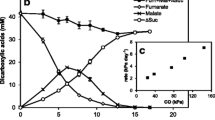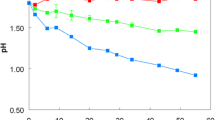Abstract
Batch cultures of Thiocapsa roseopersicina strain 6311, Thiocystis violacea strain 2311 and Chromatium vinosum strain 1611, grown anaerobically in the light on sulfide with urea, ammonia, N2 or casein hydrolysate as nitrogen source exhibited urease activity, while Chromatium vinosum strain D neither showed any degradation of urea nor urease activity on any of the nitrogen sources tested.
In T. violacea and C. vinosum strain 1611 urease was little affected by the nitrogen source and seemed to be constitutive. In T. roseopersicina, however, the enzyme was repressed by ammonia (although a low basal level of activity remained) and, to a lesser degree, induced by urea: The presense of urea stimulated a temporary increase in urease activity in the early exponential growth phase. The highest activities, however, were found after growth on N2, and especially on 0.1% casein hydrolysate (in the absence or after exhaustion of external ammonia), but not before the stationary growth phase was reached. Derepressed urease synthesis required an efficient external source of nitrogen.
In cultures of T. roseopersicina urease activity showed a periodic oscillation which depended on the repeated “feeding” with sulfide and subsequent variation in the sulfur content of the cells. The possible reasons of this oscillation are discussed.
Similar content being viewed by others
References
Bast E (1980) Ammonia assimilation by Thiocapsa roseopersicina grown on various nitrogen and carbon/electron sources. Z. Naturforsch 35c:439–444
Beisenherz G, Boltze HJ, Bücher T, Czok R, Garbade KH, Meyer-Arendt E, Pfleiderer G (1953) Diphosphofructose-Aldolase, Phosphoglyceraldehyd-Dehydrogenase, Milchsäure-Dehydrogenase, Glycerophosphat-Dehydrogenase und Pyruvat-Kinase aus Kaninchenmuskulatur in einem Arbeitsgang. Z Naturforsch 8b:555–577
Bernt E, Bergmeyer HU (1970) Methoden zur Bestimmung von Metaboliten: Harnstoff. In: Bergmeyer HU (ed) Methoden der enzymatischen Analyse, 2nd edn, vol 2. Verlag Chemie, Weinheim, pp 1738–1748
Busse W, Kaspari H, Klemme J-H (1984) Urea: an intermediate of aerobic and anaerobic purine degradation in Rhodopseudomonas capsulata. FEMS Microbiol Lett 25:33–36
Caballero FJ, Cejudo FJ, Florencio FJ, Cárdenas J, Castillo F (1985) Molecular and regulatory properties of glutamine synthetase from the phototrophic bacterium Rhodopseudomonas capsulata E1F1 J Bacteriol 162:804–809
Drutschmann M, Klemme J-H (1985) Sulfide-repressed, membrane-bound hydrogenase in the thermophilic facultative phototroph, Chloroflexus aurantiacus. FEMS Microbiol Lett 28:231–235
Engelhardt H, Klemme J-H (1981) In vivo control of glutamine synthetase in the facultative phototrophic bacterium Rhodopseudomonas sphaeroides. Z Naturforsch 36c:407–410
Friedrich B, Magasanik B (1977) Urease of Klebsiella aerogenes: Control of its synthesis by glutamine synthetase. J Bacteriol 131:446–452
Gemerden H van (1968) Growth measurements of Chromatium cultures. Arch Mikrobiol 64:103–110
Janssen DB, op den Camp HJM, Leenen PJM, van der Drift C (1980) The enzymes of the ammonia assimilation in Pseudomonas aeruginosa. Arch Microbiol 124:197–203
Johansson BC, Gest H (1977) Adenylylation/deadenylylation control of the glutamined synthetase of Rhodopseudomonas capsulata. Eur J Biochem 81:365–371
Kaltwasser H, Krämer J, Conger WR (1972) Control of urease formation in certain aerobic bacteria. Arch Mikrobiol 81: 178–196
Kaspari H, Busse W (1986) Oxidative degradation of purines by the facultative phototrophic bacterium Rhodopseudomonas capsulata. Arch Microbiol 144:67–70
König C, Schlegel HG (1967) Oscillationen der Ureaseaktivität von Hydrogenomonas H 16 in statischer Kultur. Biochim Biophys Acta 139:182–185
König C, Kaltwasser H, Schlegel HG (1966) Die Bildung von Urease nach Verbrauch der äußeren N-Quelle bei Hydrogenomonas H 16 Arch Mikrobiol 53:231–241
Krämer J, Kaltwasser H, Schlegel HG (1967) Die Bedeutung der Ureaserepression für die taxonomische Klassifizierung von Bakterien. Zbl Bakt Hyg, II. Abt 121:414–423
Magaña-Plaza I, Ruiz-Herrera J (1967) Mechanisms of regulation of urease biosynthesis in Proteus rettgeri. J Bacteriol 93:1294–1301
Malofeeva IV (1979) Assimilation of urea by purple bacteria. Mikrobiologiya 48:411–417
Menyes H, Fritsche W (1972) Regulation der Ureasesynthese in Rhodotorula mucilaginosa. Z Allg Mikrobiol 12:219–229
Niel CB van (1971) Techniques for the enrichment, isolation, and maintenance of the photosynthetic bacteria. In: Colowick SP, Kaplan NO (eds) Methods in enzymology, vol 23, Photosynthesis, part A (San Pietro A, ed). Academic Press New York London, pp 3–28
Nordlund S, Kanemoto RH, Murrell SA, Ludden PW (1985) Properties and regulation of glutamine synthetase from Rhodospirillum rubrum. J Bacteriol 161:13–17
Oberhoffer C (1977) Harnstoffabbau bei Chromatiaceae. Dipl thesis, Univ Bonn
Pfennig N, Trüper HG (1974) The phototrophic bacteria. In: Buchanan RE, Gibbons NE (eds) Bergey's manual of determinative bacteriology, 8th edn. The Williams & Wilkins Company. Baltimore, pp 24–64
Rosenstein I, Hamilton-Miller JMT, Brumfitt W (1980) The effect of acetohydroxamic acid on the induction of bacterial ureases. Invest Urol 18:112–114
Schlegel HG, Kaltwasser H (1970) Urease. In: Bergmeyer HU (ed) Methoden der enzymatischen Analyse, 2nd edn, vol 1. Verlag Chemic, Weinheim, pp 1039–1043
Schluttig A, Fritsche W (1975) Repression der Ureasebiosynthese in Neurospora crassa durch Ammoniumionen. Z Allg Mikrobiol 15:371–376
Schmidt GL, Kamen MD (1970) Variable cellular composition of Chromatium in growing cultures. Arch Mikrobiol 73:1–18
Schmidt K, Liaaen Jensen S, Schlegel HG (1963) Die Carotinoide der Thiorhodaceae. I. Okenon als Haupicarotinoid von Chromatium okenii Perty. Arch Mikrobiol 46:117–126
Slater JH, Morris I (1974) Light-dependent synthesis of glutamate in Rhodospirillum rubrum. Physiological evidence for ammonia assimilation via the glutamine synthetase and glutamine: 2-oxoglutarate aminotransferase system. Arch Microbiol 95: 337–346
Smith CJ, Bryant MP (1979) Introduction to metabolic activities of intestinal bacteria. Am J Clin Nutr 32:149–157
Thiele HH (1968) Die Verwertung einfacher organischer Substrate durch Thiorhodaceae. Arch Mikrobiol 60:124–138
Vogels GD, van der Drift C (1976) Degradation of purines and pyrimidines by microorganisms. Bacteriol Rev 40:403–468
Zorn C, Dietrich R, Kaltwasser H (1982) Regulation by repression of urease biosynthesis in Proteus rettgeri Z Allg Mikrobiol 22:197–203
Author information
Authors and Affiliations
Rights and permissions
About this article
Cite this article
Bast, E. Urease formation in purple sulfur bacteria (Chromatiaceae) grown on various nitrogen sources. Arch. Microbiol. 146, 199–203 (1986). https://doi.org/10.1007/BF00402351
Received:
Accepted:
Issue Date:
DOI: https://doi.org/10.1007/BF00402351




